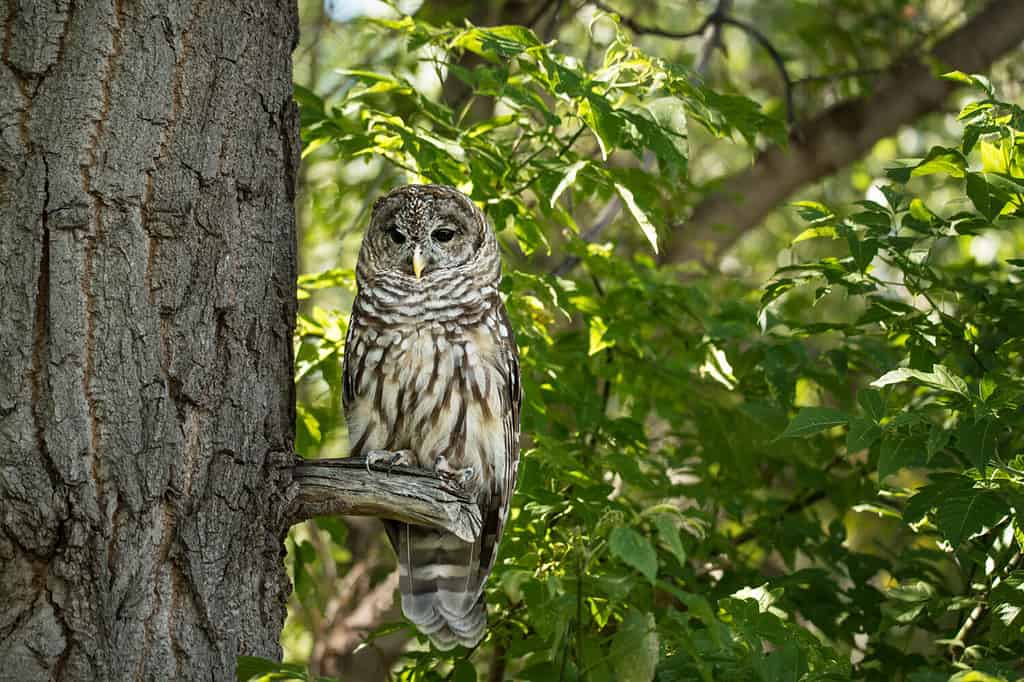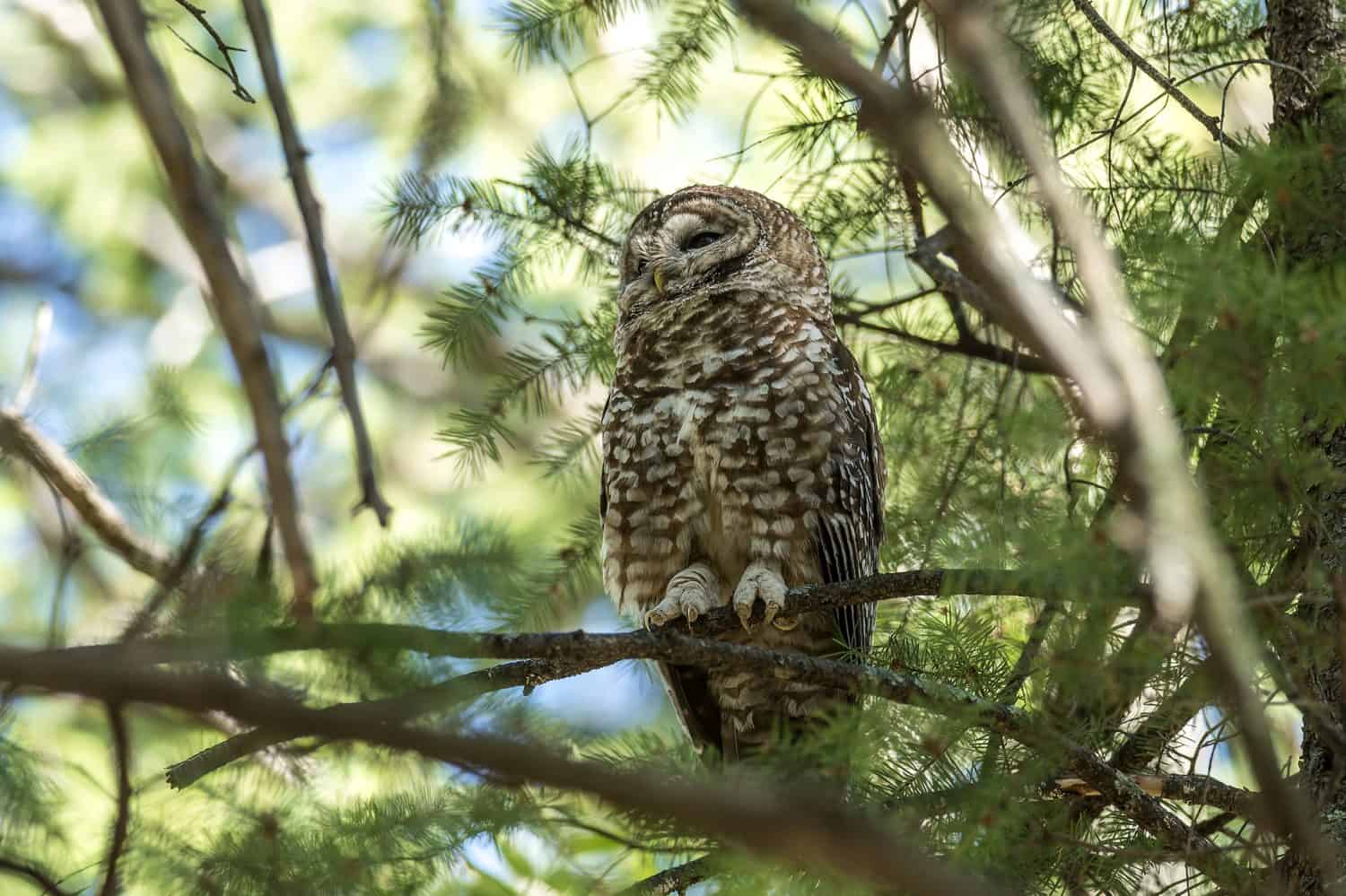Did you know that the forests of Oregon are home to a secretive bird of prey that is found only in the Pacific Northwest? The northern spotted owl is an amazing raptor with a familiar appearance and a charming call. They are also avid hunters, demonstrating renowned prowess in securing their next meal. Below, learn more about the northern spotted owl, including its hunting tactics and more!
Northern Spotted Owl: Species Summary
The northern spotted owl (Strix occidentalis caurina) is a subspecies of the spotted owl. There are two other subspecies, the Mexican spotted owl and the California spotted owl, though only the latter has a range that overlaps that of the northern spotted owl.
This owl is of medium size, with an overall brown coloration. They sport white spots on their plumage, and they lack ear tufts, unlike other owl species. Females are larger than males, with the species ranging from 16 to 19 inches in length and 1 to almost 2 pounds. They have an average wingspan of 42 inches.
Northern owls form long-term pairs. They mate in February and March, with eggs being laid approximately a month afterward. The female will incubate the eggs for around 30 days, after which the chicks will be helpless upon birth. They will fledge at around 36 days old. Even after leaving the nest, young northern spotted owls will remain in the care of their parents for many months. After they leave their parents, they will establish their own territory nearby.

Northern spotted owls are most common in Oregon.
©Georgia Evans/Shutterstock.com
Where Do Northern Spotted Owls Live?
The northern spotted owl is native to a small region in North America. They can be found as far south as northern California and as far north as British Columbia. Of all the states and regions that make up their range, this species is most abundant in Oregon.
Like other spotted owl subspecies, northern spotted owls prefer mature forests with dense canopies. However, this species has no tolerance for development and requires vast expanses of unlogged forests. They avoid recently cut areas and bushy areas. If an area has been cut, but some mature trees remain, the northern spotted owl may settle there, though it is not a preferred location.
When they nest, they do so in a dense, well-protected portion of the canopy. They may build their nest among the branches or even take over old nests abandoned by squirrels or similar animals.
What Do Northern Spotted Owls Eat?
While not the largest species of owl there is, the northern spotted owl is capable of hunting small prey as well as medium prey. Their preferred prey of choice is rodents. For the northern spotted owl, two of the most common animals to make it on the menu are the flying squirrel and the dusky-footed woodrat. This is a trait they share with the California spotted owl. However, what they do not share with this other subspecies is that the northern spotted owl will limit its range to where both of these rodents are available.
While woodrats and flying squirrels are the top prey for the northern spotted owl, they may also eat other animals. This includes:
- Bushy-tailed woodrats
- Mice
- Voles
- Snowshoe hares
- Brush rabbits
- Pocket gophers
- Bat
- Smaller owls
- Other birds
- Amphibians
- Insects.

Northern spotted owls wait for prey from their perches.
©plains-wanderer/Shutterstock.com
Northern Spotted Owl Hunting Tactics
Like other nocturnal birds, the northern spotted owl does the majority of its hunting in the dark. However, this isn’t always at night. Instead, this species will often begin hunting up to an hour before sunset. They will usually hunt through the night, finishing just before sunrise.
Northern spotted owls rely on sight and sound to capture prey. They wait, perched high on branches in the forest canopy, for the right prey to come along. Then, on silent wings, they strike, gliding down from the trees to capture their prey. They may catch their prey in mid-air, such as when hunting other birds or bats, or pluck it directly from the ground or a branch.
After capturing the prey in its powerful talons, the northern spotted owl will use its will to break the animal’s neck. This helps prevent any losses of prey while also minimizing possible injuries to the owl.
Northern Spotted Owls as an Indicator Species
Because the northern spotted owl lives in such a limited environment defined by strict characteristics, they are often viewed as an indicator species. To see one of these fascinating owls in the wild means that you have stumbled across a mature, old-growth forest.
Not only that, northern spotted owls can also act as an indicator of where other animals are present. This is because, as mentioned above, their territory overlaps with that of the flying squirrel and the dusky-footed woodrat. These birds of prey won’t stray far from where these specific prey animals are available.
Northern Spotted Owls and Barred Owls
Before learning more about northern spotted owls as at-risk species and the conservation focused on saving their populations, it is important to learn about the relationship between the northern spotted owl and the barred owl. This is because the barred owl has actually played a large role in the decline of this bird of prey.
Originally, barred owls were only present in the eastern regions of the United States and Canada. However, in recent years, the species has shifted westward, where, especially in Oregon, it is considered an invasive species. But what does this have to do with the northern spotted owl?
Because barred owls are so similar to the northern spotted owl in behavior, diet, and habitat, they often face collisions when it comes to resources. Essential resources like food and territory are scarce, and with a new species involved, there is an elevated amount of competition. This has resulted in the decline of the northern spotted owl population in Oregon. This is because there are not enough resources to support large populations of both types of birds of prey within the state. One study from 2021 found that by removing invasive barred owls from certain areas, local northern spotted owl populations stabilized—a positive change in light of severe declines.

Barred owls are invasive in the regions where northern spotted owls are native.
©FotoRequest/Shutterstock.com
Northern Spotted Owl Conservation
Concerns over the northern spotted owl and its dwindling population can be traced back to around half a century ago. In Oregon, less than 1,200 breeding pairs of the northern spotted owl remain. In surrounding states such as California and Washington, this number is less than half of that. As a result, conservation is essential in securing the future of this amazing hunter.
Invasive species like the barred owl are only one part of the equation when it comes to why the northern spotted owl, along with other spotted owl subspecies, are in such dire decline. In the 1990s, controversy surrounding the species was at large, especially due to its relationship with logging. As mentioned above, northern spotted owls thrive in mature forests with little tolerance for disruption. As a result, many environmentalists blamed the logging industry for the declining population. However, while loss of habitat does play a role in the northern spotted owl’s near-threatened status, it, much like barred owls, is only one of many different factors.
Today, breeding programs are beneficial in repopulating the Pacific Northwest with northern spotted owls. Captive breeding programs can help introduce numbers back into the wild, but awareness and further conservation are needed to help sustain these numbers as the population recovers.
The photo featured at the top of this post is © Georgia Evans/Shutterstock.com
Thank you for reading! Have some feedback for us? Contact the AZ Animals editorial team.







